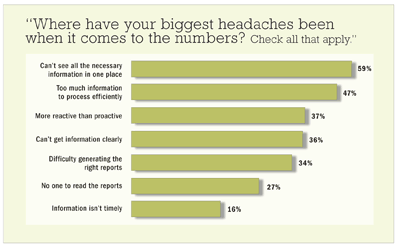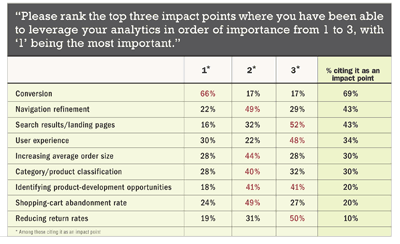Minding the Store is a classic book about retailing written by one of the all-time great merchant princes, Stanley Marcus of Neiman-Marcus fame. Its lessons for the most part are about taking care of the customer — who will then take care of you by returning to your store.
In today’s multichannel marketplace, taking care of the customer means offering an effective cross-channel strategy, best-in-class merchandising, and exemplary service, aided by targeted marketing.
All those elements came into play in The E-tailing Group’s Sixth Annual Merchant Survey. Conducted in the first quarter of 2007, the survey of 167 merchants shows the challenges of taking care of the customer while simultaneously watching the online and offline stores.
For instance, survey results illustrate how much more difficult it is becoming for online merchants to improve conversion rates and reap a greater return on investment. Current conversion rates average in the 2%-3% range but fluctuate largely between 1% and 5% depending upon merchandise category and site evolution.
In fact, fewer of this year’s respondents reported that their marketing plan was performing above expectations — 22% compared with 29% of last year’s participants. Forty-nine percent admitted to mixed results, compared with 41% last year.

Driving the right traffic to the store, increasing sales, and fostering retention all require a greater degree of personalization and segmentation, which in turn require more-sophisticated analytics and data mining. When online marketers were asked about the greatest merchandising challenges they wished to solve this year, two of the top three answers were segmentation/personalization and data/analytics. (Inventory assortment was the third.)
But while merchants understand the importance of analytics, they have neither the time nor the resources to devote to it. Nearly half of the survey respondents said their company spent fewer than 10 staff hours a week reviewing Website metrics; 80% devoted no more than 20 man-hours a week.
When asked about the biggest headaches regarding metrics, 59% of those surveyed mentioned that they can’t see all of the necessary information in one place. Not surprisingly, almost half (47%) found that they were on information overload, buried under too much data to process the information efficiently.

Yet it is imperative that you mind your online store with a clear strategy for reviewing the metrics. Managed correctly, metrics can improve almost every aspect of your business. For instance, 69% of respondents said they’d been able to improve their conversion rates by leveraging analytics. Easy wins can be had through navigational changes and continual monitoring of upgrades in the shopping cart.

As mentioned earlier, proper use of analytics is key to being able to offer more-effective and more-accurate personalization. And the merchants surveyed placed a greater value on personalization as a means of getting and keeping customers than had respondents in previous years. Forty-seven percent, for example, cited the ability to personalize products as an important offering, up from 32% the previous year.
One thing most merchants still aren’t doing is customizing communications to site visitors who abandon shopping carts. Three-fourths of those surveyed said their company did not follow up with shoppers who put something in their online cart but left before completing the purchase. Only 13% sent these visitors an e-mail reminding them of their abandoned cart and offering them an incentive to complete the transaction; another 10% sent an e-mail but offered no incentive. In fact, 29% of respondents said that their sites did not hold merchandise in abandoned carts, not even for a scant half-hour.
Catalogers have long known the importance of understanding customer lifetime value (LTV). To date, though, there seems to be limited information among multichannel marketers regarding how their customers stack up in terms of LTV by channel — another area where analytics can help.
Nearly one-fourth of respondents said they didn’t track LTV for customers acquired online, and another 36% didn’t track LTV in any channel. Yet when asked, “How do you determine how much you are willing to spend to acquire a customer online?” 38% of respondents felt it was important to break even, while 40% needed to make a profit on those acquisitions.
As in old-fashioned retailing, retention is an integral part of today’s multichannel merchant’s strategy — especially for the 60% of respondents who said they did not need to show a profit on a new customer’s first purchase. Among survey participants, e-mail was the number-one way they choose to reengage, reinforce, and retain.
These findings — and others from our complete survey — can be distilled into five steps for minding the sophisticated online store:
-
Understand that customers expect you to provide quality service, robust features, and operational dexterity, along with depth and breadth of the right product. They take it as a given that their online stores of choice will offer all of these.
-
Start with proactive planning, skilled resources, and sophisticated technology. Do not presume that your company’s growth will transpire without dedicated funding and personnel.
-
Know your customer and your competition, and use this knowledge to provide a one-stop shopping experience with the requisite tools and merchandising tactics, accessible through technology.
-
Leverage analytics to provide personalization and segmentation that will drive bottom-line results.
-
Delve into the details; doing so will reveal ample opportunities for improvement to drive sales and maintain desired profitability.
Lauren Freedman is president of The E-tailing Group, a Chicago-based consultancy for online merchants. To obtain a copy of the Sixth Annual Merchant Survey Report, contact Freedman at [email protected] or 773-975-7280.